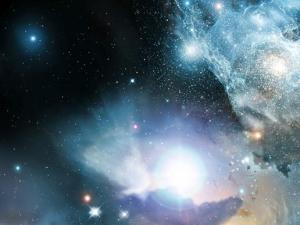In the giant galaxies that we see as quasars, the creation of new stars suddenly stopped after a baby boom that gave birth to billions of stars at once, and this is still in the young universe

Stars in galaxies are somewhat similar to humans - in the first phase of their existence, they grow fast, after that, a phase of stellar contraception begins in most galaxies.
In the picture - an artist's impression showing a quasar as it should have been, surrounded by strips of gas, star dust and first star clusters. New research suggests that these dwarf galaxies stopped producing new stars when the universe was still a baby, only 3 billion years old. The astronomers suspect that black holes, which astronomers believe are in quasars, exerted their influence to prevent the birth of new stars. Photo by NASA, European Space Agency, ESO, and researcher Wolfran Freidling.
New observations made by a Dutch astronomer named Mariska Craik at the Gemini Observatory in Hawaii and the Very Large Telescope VLT in Chile showed that some of the heavier galaxies had already stopped producing new stars when the universe was still a baby, about 3 billion years old. The astronomers suspect that black holes affected the development of the galaxy and stopped the birth of new stars.
Heavy galaxies are a boring phenomenon in the modern universe. They have an elliptical or rounded shape. The stars are evenly distributed in them and there are no more areas where new stars are formed. The large number of these stars, about 10 billion, and the low birth rate indicate the fact that the creation of new stars was high in the past. When did these stars form, and why did the creation of new stars suddenly stop?
Black holes as a contraceptive
The finite speed of light makes possible the ability to explore the universe when it was much younger than today. With the help of spectrographs, such as the Gemini Near Infrared Spectrograph and the SINFONY Very Large Telescope, Craik and her colleagues were able to study 36 massive galaxies in the early universe. These galaxies are so distant that even light took 11 billion years to reach us. Amazingly, the researchers found no evidence of star formation in a large percentage of the observed galaxies. The new discovery adds to a growing body of evidence that new star formation in massive galaxies stops suddenly after a large-scale baby boom.
The "arrest of birth" may be caused by the influence of huge black holes located in the center of those galaxies. The large amount of matter pulled into the black holes creates a large amount of energy that eventually heats the gas in the galaxy. The result of this heating is the cessation of the ability to form new stars. The researchers did discover a black hole in several of the galaxies they studied. These were mainly galaxies where the process of creating galaxies was suppressed less than a billion years ago (minus the effect of the speed of light of course). These results support the idea that black holes limit the birth of new stars.
For the announcement of the Netherlands Institute for Scientific Research

One response
Why does warming cause no stars to form? After all, it is easy to create a star that raises the temperature. Maybe it's because the heat lowers the density of the material?